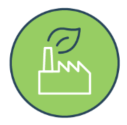Insight
Australian industries like metals, chemicals and refining are crucial for its economy and are currently facing challenges in reducing emissions. Decarbonisation is supported with initiatives like the Future Made in Australia Innovation Fund, Powering the Regions Fund, and the National Reconstruction Fund Corporation. Key measures, including the Safeguard Mechanism and the Net Zero Industrial Sector Plan, along with flagship projects to reduce steelmaking emissions are advancing towards net-zero emissions by 2050.
Industry GHG Emissions
In 2022, Australia’s GHG energy emissions from the sector Energy – Stationary fuel combustion for Manufacturing industries & construction totalled 43.1 million tonnes CO2-equivalent. Here the metal industry was the largest contributor, followed by manufacturing of machinery, textiles, pulp, paper & print and basic chemical manufacturing.
Emissions from the Industrial Processes sector include 33 million tonnes CO2-equivalent, with the largest emissions from metals and product substitutes for ozone (both at 11 million tonnes), followed by minerals (5 million tonnes) and chemicals (3 million tonnes).
Sectors Overview
Australia offers statistics along the Australian and New Zealand Standard Industrial Classification (ANZSIC). Industrial areas are distributed throughout the country, with key hubs in Pilbara, Kwinana, Illawarra, Hunter and Gladstone.
In 2021 the Metal sector, crucial to global trade in ferrous ores and lithium, employed 72,600 people, with a turnover of 71.6 billion AUD.
Australia’s Chemical and Refining sector employed over 58,000 people in 2021, generating a net turnover of 51.9 billion AUD.
In 2020, production included approximately 5.3 million tonnes of Clinker, 9.6 million tonnes of Cement, and 1.5 million tonnes of Lime. This activity generated a net turnover of 13.5 billion AUD and provided jobs for over 11,600.
Economic Relevance Of Sector
Chemicals & Refining
Annual net turnover (2021):
51.9 billion AUD
Number of employees (2023):
58,000
Export value (2023):
15.9 billion AUD
Biggest companies based on turnover:
Glencore, Wesfarmers, Ampol, BP Australia, Chevron Australia
Main export markets:
Ship and Aircraft Stores (21%), USA, China, New Zealand, Japan
Metals Including Iron & Steel
Annual net turnover (2021):
71.6 billion AUD
Number of employees (2023):
72,600
Export value (2023):
51.7 billion AUD
Biggest companies based on turnover:
Rio Tinto, BHP, The Perth Mint, BlueScope Steel, Hancock
Main export markets:
China (21%), Hongkong (11.6%), India, UK, South Korea
Cement & Lime
Annual net turnover (2021):
13.5 billion AUD
Number of employees (2023):
11,600
Export value (2023):
55.6 million AUD
Biggest companies based on turnover:
Seven, Fletcher Building, James Hardie Industries, CSR, Hanson Australia Holdings
Main export markets:
New Zealand (63.8%), Spain (12.5%), Papua New Guinea, USA, Vietnam
Knowledge Sharing and R&D Capabilities – Key Contacts
The Australian Renewable Energy Agency (ARENA) offers programs in place to share knowledge, insights and data from funded projects to help the renewable energy industry and other projects learn from experience.
The Heavy Industry Low-carbon Transition Cooperative Research Centre (HILT CRC) is a collaborative venture that brings together industries, researchers, and government organisations to share the responsibility for the big shift of decarbonisation.
Decarbonising Industry – Funding Opportunities
The Future Made in Australia – Innovation Fund supports innovation, commercialisation, pilot and demonstration projects and early-stage development in priority sectors, including renewable hydrogen, green metals, low carbon and clean energy technology manufacturing such as batteries. The Fund is a key initiative under the $22.7 billion Future Made in Australia initiative.
Total funding volume:
1.7 billion AUD
The Powering the Regions Fund (PRF) allocates funding to support four key areas: decarbonising existing industries, developing new clean energy sectors, workforce development, and purchasing carbon credits to facilitate the transition to net zero emissions.
Total funding volume:
1.9 billion AUD
Australia has several public organisations that support RD&D and early-stage commercialisation of industrial decarbonisation technologies through co-investment with the private sector, including ARENA, CEFC, and CRCs.
The National Reconstruction Fund Corporation (NRFC) invests in projects to support manufacturing across seven priority areas including renewables & low emission technologies, and resources like minerals and metals. The NRFC delivers NRF funding as an independent financier.
Total funding volume:
15 billion AUD
In 2024 Australia and Austria launched a joint call for industrial decarbonisation for pilot/test projects.
Total funding volume:
24 million AUD
Relevant Policies & Roadmaps
The Safeguard Mechanism is a policy by the Australian Government to reduce emissions from the nation’s largest industrial sites. Started in 2016 and reformed in 2023, it sets declining emission limits for facilities emitting over 100,000 tonnes of CO2 equivalent per year. This includes sectors like mining, oil and gas, manufacturing, transport, and waste management. The mechanism aims to help Australia achieve net zero by 2050, while maintaining industrial competitiveness.
The Australian Government’s Net Zero Industrial Sector Plan (NZISP) is an industry focussed emissions reduction plan that will outline the role of industry in supporting Australia’s transition to net zero. This plan is one of six sectoral plans, together they cover the whole of the economy and will plot a course for Australia’s strategy to meet its 2035 and 2050 emission reduction targets.
Flagship Projects
BlueScope has been awarded 136.8 million AUD towards the reline and upgrade of its No. 6 Blast Furnace at the Port Kembla Steelworks. This project will maintain domestic production, reduce emissions, and support pathways to producing even lower-emissions steel in the future.
LIBERTY has also been awarded 63.2 million AUD towards the purchase and commission of a low carbon electric arc furnace (EAF) to replace the existing traditional blast furnace at the Whyalla Steelworks. The new state of the art EAF will support the manufacturing of green steel and help achieve LIBERTY’s aim of carbon neutrality by 2030.

